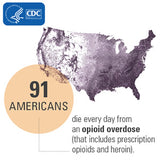A good thing is going on. People are re-evaluating how to deal with low back and neck pain. Clinicians are critically appraising the treatment methods they use and patients are educating themselves on the various options that exist in order to get the best possible treatment for their back pain with the least amount of side effects. The growing awareness of the risks posed by excessive opioid use is a major driver of this shift in thinking.
Last Thursday the President declared the opioid crisis an epidemic and a national emergency. This declaration came at the recommendation of the President’s Commission on Combating Drug Addiction and the Opioid Crisis. This move will free up resources for state and federal agencies to combat this vexing problem. To get a sense of how real the problem is, consider the following statistics (from cdc.gov):
- Sales of prescription opioids in the U.S. nearly quadrupled from 1999 to 2014,1 but there has not been an overall change in the amount of pain Americans report.
- Primary care providers account for about half of opioid pain relievers dispensed.
- Nearly half of all U.S. opioid overdose deaths involve a prescription opioid.
- In 2014, almost 2 million Americans abused or were dependent on prescription opioids.
- As many as 1 in 4 people who receive prescription opioids long term for noncancer pain in primary care settings struggles with addiction.
 
|
 
|
 
|
Opioids are not the problem in and of themselves. Addiction to them is. Opioids are appropriate and safe when prescribed and used under close medical supervision and usually only after other conservative methods of care have been tried. But here is the key question – are there good alternative methods of managing low back and neck pain?
The answer is yes and we’ll review two of them here – mechanical traction (also sometimes referred to as decompression) and electrical stimulation or TENS. The reason that it is worth highlighting these interventions is that awareness of their potential is too low among prescribers and patients. This stuff works but not enough people know about it!
Intermittent mechanical traction
Clinicians have applied traction to the spine for back and neck pain for centuries. When the structures around the spine are hurting, there are often areas of increased internal pressure because of a bulging disc or local swelling. Pulling the vertebras away from one another helps decrease this pressure and relieve the pain and inflammation. When done in an intermittent way (pull-release-pull-release), the results are usually quick and very noticeable.
Manual therapists often apply traction with their hands but mechanical devices are increasingly added to the arsenal of treatment tools. They used to be large and a bit clunky but not anymore. Modern devices used in the clinic are sophisticated, much smaller and more affordable. Read some more on this modality in this post.
TENS for low back pain

Electrical current is also nothing new. The whole body depends on electricity in nerves, muscles and organs to function properly. It is logical and intuitive that applying electricity to the body in pain has the potential to nudge it back to health. And indeed, it works. Scientific research clearly confirms that delivering small electrical pulses can make the pain decrease substantially, thereby reducing the need to take as much pain medication. And technology is now so much easier to use and so much more affordable that patients simply buy these devices themselves to help manage their pain. Read here for an interesting story about how a short trial of TENS helped a patient with severe low back pain.
So whether you are a clinician looking for drug-free alternatives to treat persistent low back and neck pain, or you are a patient looking for ways to make your pain go away without having to take more pills, my encouragement to you is to explore these methods above. Ask your therapist whether these products can help you and try them out! The research is clear, chances are that they will be of significant benefit to you.

Yorick Wijting, PT, DPT (www.specialistpt.com) received his degree in Physical Therapy in the Netherlands and later his DPT at the University of St. Augustine in Florida. He has practiced physical therapy in various care settings across Europe, South Africa and the United States. He has extensive training and practical experience in electrotherapy and teaches nationally and internationally to medical professionals on its therapeutic use. He is passionate about helping clinicians discover how technology can enhance their efficiency and treatment outcomes.

